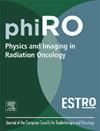转移性放射治疗中立体定向光子与质子治疗方案的比较
IF 3.3
Q2 ONCOLOGY
引用次数: 0
摘要
背景和目的在转移导向治疗(MDT)中,实现最佳局部控制是延迟进一步转移扩散的关键。生物等效剂量(BED)和局部控制之间的明确相关性,当BED超过100 Gy时,使用α:β比为3,其率达到99%,强调了研究先进辐射方式的重要性。材料,方法对20例38个病灶的患者进行放射计划研究,比较光子和质子立体定向放射治疗对少进展性转移性去势难治性前列腺癌患者的疗效。主要目的是确定质子治疗是否达到了令人满意的BED3。与光子治疗相比,在尊重危险器官的剂量限制的情况下,使用体素最小剂量的100 Gy治疗更多的患者。结果体积调节电弧治疗(VMAT)和强度调节质子治疗(IMPT)达到了令人满意的BED3 >;100戈瑞的病例分别为75%和78%。在元音最小总肿瘤体积(GTV) D99% (p <;0.001)。IMPT提供了重要的危险器官(OAR)保留,使其成为减少长期毒性的有希望的方式。结论质子治疗可减少长期治疗相关的毒副作用,对再照射更有效。达到了令人满意的BED3 >;在100 Gy以上的患者中,光子治疗在体素最小GTV D99%方面具有统计学上显著的优势。本文章由计算机程序翻译,如有差异,请以英文原文为准。
Comparison of stereotactic photon and proton treatment plans for metastasis-directed radiotherapy
Background and purpose
Achieving optimal local control is pivotal in the context of metastasis-directed therapy (MDT) in delaying further metastatic spread. The clear correlation between the biological equivalent dose (BED) and local control, with rates reaching 99 % when BED exceeds 100 Gy using an α:β ratio of 3, underlines the importance of investigating advanced radiation modalities.
Materials & methods
A planning study was conducted in 20 patients treated for 38 lesions to compare photon based and proton based stereotactic radiation therapy in oligoprogressive metastatic castration-refractory prostate cancer patients. The primary objective was to determine whether proton therapy is achieving a satisfactory BED3 of > 100 Gy using the voxel wise minimum dose in more patients when compared with photon therapy respecting the dose constraints for the organs-at-risk.
Results
Volumetric Modulated Arc Therapy (VMAT) and Intensity Modulated Proton Therapy (IMPT) achieved a satisfactory BED3 > 100 Gy in 75 % and 78 % of the cases, respectively. A significance difference was observed in favor of IMPT for vowel-wise minimum gross tumor volume (GTV) D99% (p < 0.001). IMPT provided significant organs at risk (OAR) sparing, making it a promising modality for reducing long-term toxicities.
Conclusion
Proton therapy may reduce long-term treatment-related toxicities and be more effective for re-irradiation. It achieves a satisfactory BED3 of > 100 Gy in more patients as photon therapy with a statistically significant advantage in voxel wise minimum GTV D99%.
求助全文
通过发布文献求助,成功后即可免费获取论文全文。
去求助
来源期刊

Physics and Imaging in Radiation Oncology
Physics and Astronomy-Radiation
CiteScore
5.30
自引率
18.90%
发文量
93
审稿时长
6 weeks
 求助内容:
求助内容: 应助结果提醒方式:
应助结果提醒方式:


